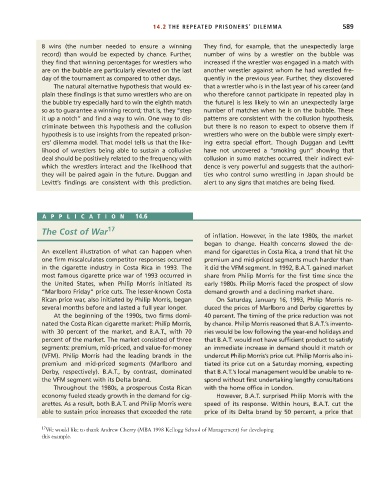Page 615 - Microeconomics, Fourth Edition
P. 615
c14gametheoryandstrategicbehavior.qxd 8/6/10 8:22 AM Page 589
14.2 THE REPEATED PRISONERS’ DILEMMA 589
8 wins (the number needed to ensure a winning They find, for example, that the unexpectedly large
record) than would be expected by chance. Further, number of wins by a wrestler on the bubble was
they find that winning percentages for wrestlers who increased if the wrestler was engaged in a match with
are on the bubble are particularly elevated on the last another wrestler against whom he had wrestled fre-
day of the tournament as compared to other days. quently in the previous year. Further, they discovered
The natural alternative hypothesis that would ex- that a wrestler who is in the last year of his career (and
plain these findings is that sumo wrestlers who are on who therefore cannot participate in repeated play in
the bubble try especially hard to win the eighth match the future) is less likely to win an unexpectedly large
so as to guarantee a winning record; that is, they “step number of matches when he is on the bubble. These
it up a notch” and find a way to win. One way to dis- patterns are consistent with the collusion hypothesis,
criminate between this hypothesis and the collusion but there is no reason to expect to observe them if
hypothesis is to use insights from the repeated prison- wrestlers who were on the bubble were simply exert-
ers’ dilemma model. That model tells us that the like- ing extra special effort. Though Duggan and Levitt
lihood of wrestlers being able to sustain a collusive have not uncovered a “smoking gun” showing that
deal should be positively related to the frequency with collusion in sumo matches occurred, their indirect evi-
which the wrestlers interact and the likelihood that dence is very powerful and suggests that the authori-
they will be paired again in the future. Duggan and ties who control sumo wrestling in Japan should be
Levitt’s findings are consistent with this prediction. alert to any signs that matches are being fixed.
APPLICA TION 14.6
The Cost of War 17
of inflation. However, in the late 1980s, the market
began to change. Health concerns slowed the de-
An excellent illustration of what can happen when mand for cigarettes in Costa Rica, a trend that hit the
one firm miscalculates competitor responses occurred premium and mid-priced segments much harder than
in the cigarette industry in Costa Rica in 1993. The it did the VFM segment. In 1992, B.A.T. gained market
most famous cigarette price war of 1993 occurred in share from Philip Morris for the first time since the
the United States, when Philip Morris initiated its early 1980s. Philip Morris faced the prospect of slow
“Marlboro Friday” price cuts. The lesser-known Costa demand growth and a declining market share.
Rican price war, also initiated by Philip Morris, began On Saturday, January 16, 1993, Philip Morris re-
several months before and lasted a full year longer. duced the prices of Marlboro and Derby cigarettes by
At the beginning of the 1990s, two firms domi- 40 percent. The timing of the price reduction was not
nated the Costa Rican cigarette market: Philip Morris, by chance. Philip Morris reasoned that B.A.T.’s invento-
with 30 percent of the market, and B.A.T., with 70 ries would be low following the year-end holidays and
percent of the market. The market consisted of three that B.A.T. would not have sufficient product to satisfy
segments: premium, mid-priced, and value-for-money an immediate increase in demand should it match or
(VFM). Philip Morris had the leading brands in the undercut Philip Morris’s price cut. Philip Morris also ini-
premium and mid-priced segments (Marlboro and tiated its price cut on a Saturday morning, expecting
Derby, respectively). B.A.T., by contrast, dominated that B.A.T.’s local management would be unable to re-
the VFM segment with its Delta brand. spond without first undertaking lengthy consultations
Throughout the 1980s, a prosperous Costa Rican with the home office in London.
economy fueled steady growth in the demand for cig- However, B.A.T. surprised Philip Morris with the
arettes. As a result, both B.A.T. and Philip Morris were speed of its response. Within hours, B.A.T. cut the
able to sustain price increases that exceeded the rate price of its Delta brand by 50 percent, a price that
17 We would like to thank Andrew Cherry (MBA 1998 Kellogg School of Management) for developing
this example.

